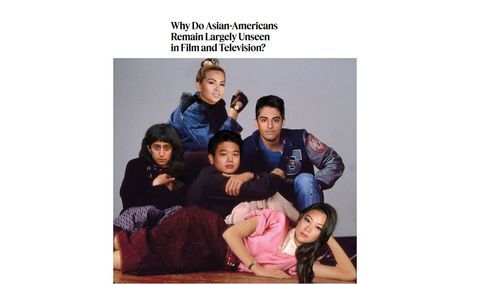
Sailer’s Law Of Female Journalism: The Racial Resentment Bandwagon
By Steve Sailer
11/10/2018
Since 2009, I’ve gotten a lot of mileage out of Sailer’s Law of Female Journalism: “The most heartfelt articles by female journalists tend to be demands that social values be overturned in order that, Come the Revolution, the journalist herself will be considered hotter-looking.”
 But female journalists continue to strive tirelessly to make my snark look like a Law of Nature. For example, here’s a colossal new article in the New York Times by a white-looking part-Asian fashion editor:
But female journalists continue to strive tirelessly to make my snark look like a Law of Nature. For example, here’s a colossal new article in the New York Times by a white-looking part-Asian fashion editor:
Why Do Asian-Americans Remain Largely Unseen in Film and Television?
By Thessaly La Force
Nov. 6, 2018
Her giant essay, like so many other lady journalists’ in recent years, is about how devastating it is for an Asian woman like her to look in the mirror in this racist society due to all the White Privilege you white people have. Yet, in her case, she is 6 feet tall and looks like a Bosnian lady volleyball player. She’s less East Asian-looking than Melania Trump. She recently married a guy who looks like Ryan Gosling’s brother.
THEIR FACES ARE familiar for the feelings of horror and shame they produce in me. Mickey Rooney as Mr. Yunioshi in 1961’s “Breakfast at Tiffany’s,” stumbling around his Manhattan apartment in a blue bathrobe, his face contorted — lips barely closing over grotesquely pronounced buckteeth, slicked-back hair dyed jet black. …
Etcetera Etcetera …
It is only when we are hidden that we are allowed to succeed. Which leads to a more troubling but inevitable conclusion: that there is something about the very physiognomy of the Asian face that American audiences still cannot or will not accept. …
The bamboo ceiling.
And so it all comes back to how we are allowed to see ourselves on the screen: worker bees but not the inventor. …
After the release this past summer of “Crazy Rich Asians,” a romantic comedy about a young woman who discovers her boyfriend’s enormous wealth (and one of only three major Hollywood films ever to have a majority Asian cast), I’ve fantasized about recasting various classic American films with faces that look like mine. What if “Ferris Bueller” took place in Pasadena and not Chicago, if its projection of youthful freedom and dilettantish attention span — youth is now, and now is free — were something you could see played out among a well-to-do Chinese family? …
Norman Rockwell pictures This is the second NYT article this week celebrating an extremely lame trend to take nostalgic old movies or
This is the second NYT article this week celebrating an extremely lame trend to take nostalgic old movies or
Perhaps, other Asian-Americans have argued, we aren’t vocal enough. We don’t get worked up, we don’t cause a fuss. Our parents don’t encourage us to take risks, to rebel. We are too polite, too cautious.
But I don’t buy it. I think that you refuse to see us. To look at us for who we are. …
When I was 10 years old, I stole a blond wig from the theater camp I attended that summer. I wore it alone in my room. I paraded in front of my mirror with it perched on my head like the feathers of a cockatoo. When it was on, I let myself fantasize about being a white girl. It was then that the more Chinese side of me became visible. The beige and yellow undertones of my skin clashed with the golden yellow of the wig. The almond shape of my brown eyes didn’t sit as well as the pretty blue eyes I imagined having beneath the flaxen bangs. I was trying to erase a side of myself. But in doing so, I only saw myself more clearly.
Our wedding pictures (plus a short thing I wrote about it) on @voguemagazine: https://t.co/wJzBwRn3y2
— Thessaly La Force (@Thessaly) November 7, 2018
